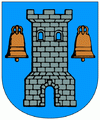Tårnby Municipality (Tårnby Kommune)
 |
The municipality is primarily an amalgamation of the formerly independent towns of Tårnby and Kastrup, as well as the earlier villages of Ullerup and Tømmerup. The municipal council is located in the Kastrup section of the municipality. Tårnby municipality was not merged with other municipalities on 1 January 2007 as part of nationwide Kommunalreformen ("The Municipal Reform" of 2007).
Tårnby is divided into three main built up districts: Kastrup, Tårnby, and Vestamager. Kastrup in the north-east is marked by higher density apartments and harbour facilities; Tårnby, west of Kastrup, is known for its older houses, row houses, and some apartments; Vestamager, to the west of the airport, is known for its smaller houses and gardens. Most of the community's infrastructure is fairly evenly spread throughout the municipality.
Neighbouring municipalities are Copenhagen to the north and Dragør to the south. These three municipalities cover the entirety of Amager island. To the east is the Øresund (the Sound), the strait which separates Zealand from Sweden. To the west is Køge Bay (Køge Bugt).
The E20 Amager Motorway (Amagermotorvejen) / Øresund Motorway (Øresundsmotorvejen) runs through Tårnby, where in the east it crosses over the Øresund and over the island of Peberholm to Sweden as the Øresund Bridge, and to the west it crosses over Køge Bay to Avedøre Holme in Hvidovre municipality as the 241-meter long Kalvebod Bridge (Kalvebodbroen).
Most of Copenhagen Airport lies in the municipality. In fact, the airport takes up about 19% of the municipality's area. The airport has had a strong impact on the area, as the national significance of the international airport has sometimes taken precedence over local wishes. However, the airport is also a major employer and benefit for the local economy.
Demographically, Tårnby is slightly older than most of Copenhagen. This trend is expected to become more pronounced in the coming years. Income is slightly less than the average of the approximately 20 municipalities closest to the municipality of Copenhagen.
Politically the municipality has been very stable. From the 1930s until the early 21st century there were only 4 different mayors, all social democrats. The town council has always a majority of social democrats. The municipality has the 5th. lowest tax rate in Denmark. However, the service level is still relatively high.
The first mention of Tårnby in the historical record was in 1135.
Much of the community was still quite rural until the mid 20th century when expansion of the airport, construction of new highways and streets, and a population boom in Copenhagen encouraged the construction of apartments and row housing.
Map - Tårnby Municipality (Tårnby Kommune)
Map
Country - Denmark
 |
 |
| Flag of Denmark | |
As of 2013, the Kingdom of Denmark, including the Faroe Islands and Greenland, has a total of 1,419 islands above 100 m2; 443 of which have been named and of which 78 are inhabited. Spanning a total area of 42943 km2, metropolitan Denmark consists of the northern part of the Jutland peninsula and an archipelago of 406 islands. Of these, the most populated island is Zealand, on which the capital Copenhagen is situated, followed by Funen, the North Jutlandic Island, and Amager. Denmark's geography is characterised by flat, arable land, sandy coasts, low elevation, and a temperate climate. As of 2022, it had a population of 5.928 million (1 October 2022), of which 800,000 live in the capital and largest city, Copenhagen. Denmark exercises hegemonic influence in the Danish Realm, devolving powers to handle internal affairs. Home rule was established in the Faroe Islands in 1948 and in Greenland in 1979; the latter obtained further autonomy in 2009.
Currency / Language
| ISO | Currency | Symbol | Significant figures |
|---|---|---|---|
| DKK | Danish krone | kr | 2 |
| ISO | Language |
|---|---|
| DA | Danish language |
| EN | English language |
| FO | Faroese language |
| DE | German language |















